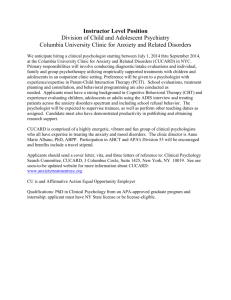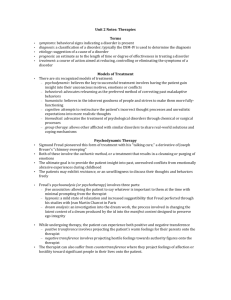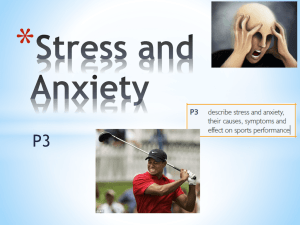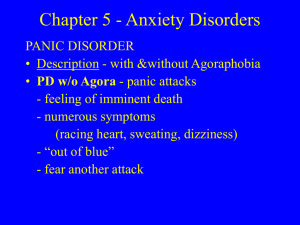Cog Biases in Anxiety Syllabus 2015
advertisement
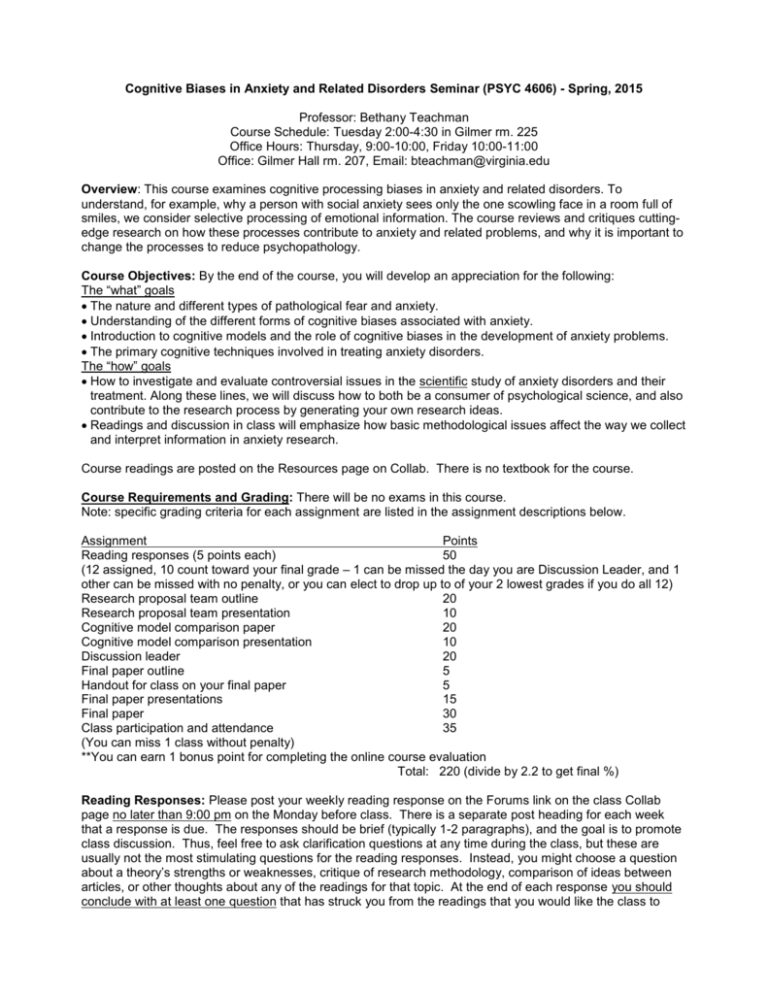
Cognitive Biases in Anxiety and Related Disorders Seminar (PSYC 4606) - Spring, 2015 Professor: Bethany Teachman Course Schedule: Tuesday 2:00-4:30 in Gilmer rm. 225 Office Hours: Thursday, 9:00-10:00, Friday 10:00-11:00 Office: Gilmer Hall rm. 207, Email: bteachman@virginia.edu Overview: This course examines cognitive processing biases in anxiety and related disorders. To understand, for example, why a person with social anxiety sees only the one scowling face in a room full of smiles, we consider selective processing of emotional information. The course reviews and critiques cuttingedge research on how these processes contribute to anxiety and related problems, and why it is important to change the processes to reduce psychopathology. Course Objectives: By the end of the course, you will develop an appreciation for the following: The “what” goals The nature and different types of pathological fear and anxiety. Understanding of the different forms of cognitive biases associated with anxiety. Introduction to cognitive models and the role of cognitive biases in the development of anxiety problems. The primary cognitive techniques involved in treating anxiety disorders. The “how” goals How to investigate and evaluate controversial issues in the scientific study of anxiety disorders and their treatment. Along these lines, we will discuss how to both be a consumer of psychological science, and also contribute to the research process by generating your own research ideas. Readings and discussion in class will emphasize how basic methodological issues affect the way we collect and interpret information in anxiety research. Course readings are posted on the Resources page on Collab. There is no textbook for the course. Course Requirements and Grading: There will be no exams in this course. Note: specific grading criteria for each assignment are listed in the assignment descriptions below. Assignment Points Reading responses (5 points each) 50 (12 assigned, 10 count toward your final grade – 1 can be missed the day you are Discussion Leader, and 1 other can be missed with no penalty, or you can elect to drop up to of your 2 lowest grades if you do all 12) Research proposal team outline 20 Research proposal team presentation 10 Cognitive model comparison paper 20 Cognitive model comparison presentation 10 Discussion leader 20 Final paper outline 5 Handout for class on your final paper 5 Final paper presentations 15 Final paper 30 Class participation and attendance 35 (You can miss 1 class without penalty) **You can earn 1 bonus point for completing the online course evaluation Total: 220 (divide by 2.2 to get final %) Reading Responses: Please post your weekly reading response on the Forums link on the class Collab page no later than 9:00 pm on the Monday before class. There is a separate post heading for each week that a response is due. The responses should be brief (typically 1-2 paragraphs), and the goal is to promote class discussion. Thus, feel free to ask clarification questions at any time during the class, but these are usually not the most stimulating questions for the reading responses. Instead, you might choose a question about a theory’s strengths or weaknesses, critique of research methodology, comparison of ideas between articles, or other thoughts about any of the readings for that topic. At the end of each response you should conclude with at least one question that has struck you from the readings that you would like the class to discuss. This could be a point you disagreed with, or a broader question about the implications of a particular study design or theory. If you are going to be away, you can still post your response. Grading will be based on depth of thought, originality and writing style (5 points per response; you will lose 1 point if you post after 9 pm but before noon Tuesday). Total= 50 points. Research Proposal Outline (2-3 pages): You will be placed into teams of 3-4 people, and challenged to develop a research proposal to address one of the ‘unanswered questions’ raised by the class readings. The proposal should reflect a design that is NOT an exact replication of another study that has been done (though it is recommended that you use previous research in the area to help you develop your idea). A Research Design Worksheet is posted on the Assignments page at the Collab class site to guide you through the steps to be completed (it includes 13 questions, which are worth 17 points total, plus 3 points are assigned for overall style and thoughtfulness of the design). Total= 20 points. (All members of the team will receive the same grade). Research Proposal Team Presentation: The presentations should be a maximum of 12 minutes (they will be timed and you will lose points for going over time). The goal of the presentation is to bring your research question and design to life. Help the class get excited by the idea you’ve proposed, and be prepared for questions from the class about why you made the design choices you did. Presentations should be engaging, so 5 points will go toward the style and delivery of the presentation (tips: don’t read the entire thing & don’t put too many words on each slide!), and 5 points will go toward the content of the presentation (students should have a clear idea of why your question is an interesting one and how your study will be one step toward answering that question). The topics you are expected to cover in your slides include the following (though you should not feel obligated to follow this outline if you have a different approach you’d prefer): a) your research question; b) why this question is important/theoretical background; c) basics of the study design and why you chose these design features (e.g., participants, independent and dependent variables, basic overview of the procedures); d) your hypotheses (and why you expect those results); e) what this study will teach us (i.e., how it can help to answer your main research question). Total= 10 points. (All members of the team will receive the same grade). Cognitive Model Comparison Paper: Write a short research paper comparing and contrasting how a cognitive model of anxiety and an alternate model/theoretical orientation (e.g., interpersonal, attachment, psychodynamic, acceptance and commitment, behavioral, client-centered…) view a specific aspect of an anxiety disorder OR a topic related to development or treatment of anxiety. Sample topics include: the role of early childhood experiences in the development of anxiety, the expected impact of parenting styles on the development of anxiety, why traumas lead to PTSD for some people, but not others. You are strongly encouraged to clear your topic with the instructor at least 1 week before the paper is due to receive feedback on whether the scope of your topic is likely to work well for the assignment. This can be done over e-mail or in person during office hours. A minimum of three references is required. The paper should be 3-4 pages (not including references), double-spaced, have 12 point Times New Roman font, one inch margins on all sides, and use APA style. Papers should be saved as Microsoft Word documents and e-mailed to the instructor prior to class on the due date. Note, if you're having trouble narrowing down your topic for the paper, I recommend you start with a review paper for a cognitive model of a given anxiety disorder (e.g., cognitive or cognitive-behavioral model of social anxiety or panic or PTSD or OCD, etc.) and think about what aspect of that model interests you (e.g., could be something about the proposed etiology of the disorder, or something about the theoretical mechanisms of change over therapy, or some key feature of the disorder's symptom presentation). You can then look at another model's view on that same issue (e.g., a biological, or psychodynamic, or interpersonal, or attachment perspective on that disorder's etiology, mechanisms of treatment change, etc.). This is NOT the only approach that can work for picking your paper topic - just an easy approach if you're feeling stuck. Grading: 5 points for describing how cognitive models view the topic and noting the extent of empirical evidence in support of the model, 5 points for describing how a different model/orientation views the topic and noting the extent of empirical evidence in support of the model, 5 points for thoughtful comparing/contrasting of the two views, plus 5 points are assigned for overall style, organization, clarity and proofreading, and following APA reference style. Total= 20 points. Cognitive Model Comparison Presentation: The presentation should be a maximum of 5 minutes (they will be timed and you will lose points for going over time). The goal of the presentation is to summarize the two different views you compared in the paper so all students can learn about a broad range of models/orientations. Again, presentations should be engaging so 5 points will go toward the style and delivery of the presentation, and 5 points will go toward the content of the presentation (students should be able to summarize the two models at the end of the presentation and understand in what ways they are similar or different, and the evidence supporting each model). Total= 10 points Discussion Leader Day: During most classes (when there are not other presentations), two students will be the appointed Discussion Leaders. You will select your day during the first class. Students are encouraged to be creative when it’s their turn to lead discussion to best promote active participation. You will jointly lead the class for approx. 30 minutes, so each person covers ~15 minutes. The preparatory work will primarily involve generating a number of discussion questions to raise with the class, incorporating questions/ideas from your classmates’ blog entries (posted the previous evening), and bringing in at least 1 additional source of material related to that week’s topic (that was not part of the assigned readings) to share with the class. This could be an additional research article (that you would summarize), a magazine or newspaper story or other form of media, a video clip from YouTube or scene from a TV show or movie (video materials should be a maximum of 5 minutes of your time), a passage from a novel…your choice! You do not have to submit a Reading Response the day you are Discussion Leader. Grading: 10 points for depth and quality of questions raised and content discussed (including your presentation of new source material), 5 points for ability to promote participation and incorporate ideas from classmates’ blog entries, and 5 points for style, organization, and creativity. Total= 20 points Final Paper (maximum15 pages, not including references): The final paper will be based on a topic of your choice in any area related to cognitive processing in anxiety disorders. The goal is to choose a controversial area and to take a position on this controversy. Sample topics include whether children should be expected to show the same cognitive biases as adults, what is the mechanism underlying attention bias modification, why are results for cognitive bias modification on the web not as strong as they are in the lab, under what conditions will cognitive change lead to affect and symptom change. You are expected to present a range of arguments on the issue, but also note why you have selected a particular thesis. It will be important for you to read the original sources so that you can evaluate the research methodology in defining your position on the issue. Important qualities in the paper will be depth of thinking, clarity of arguments, and ability to analyze and synthesize a range of resources in order to develop your own position. Once you have outlined a topic and argued your position (this will take approximately half of the paper), you should propose a study that could be used to help test your position. The study proposal component should include the basic procedures and measures to be used, as well as a description of the proposed sample(s) and your hypotheses (you can use similar headings to those used for the team research proposal). Also, it should be clear how this study will help to test some aspect of your position on the issue. Similar to the earlier team proposal assignment, this proposal should reflect a design that is NOT an exact replication of another study that has been done, but you will need to use previous research in the area to help you develop your idea (and there is nothing wrong with replicating aspects of a previous design; e.g., using measures or paradigms that are already well established). Grading will be based on covering the content listed above (5 points for outlining the topic, 10 points for showing depth of thinking in your arguments and effectively using research to back up your positions, and 10 points will be allotted for the research proposal components), and then 5 points will be assigned based on quality of the writing, organization, and accurately using APA reference style. Total= 30 points. Final Paper Outline (1 page): Prior to submission of the paper, all topics must be approved. Please submit a paper outline that very briefly explains the topic, the basic structure of the paper (e.g., main arguments you will consider), and your tentative thesis. You can also outline your proposed research design if you wish. The following subheadings can help ensure you include the key information: a) what is the controversy/open question?; b) arguments/theory/empirical research on one side; c) arguments/theory/empirical research on other side(s); c) your position and rationale for the position; d) how can you set up a test to help figure out the answer to this question (optional for outline). A key challenge is to make sure the study you’ve designed will shed light on your specific question. Total= 5 points. Handout For Class On Your Final Paper: Please prepare a 1-page handout for the class that students can keep as a resource to teach them about the topic and thesis you’ve selected. Think about what you most want people to remember from your presentation, and what will be most valuable to them as a resource to look back on in the future. The handout will be graded on interest value, how informative it is, and how effectively it communicates your position. It is your choice whether you also include information about your proposed research design in the handout. Total= 5 points. Final Paper Presentation: The presentation should be a maximum of 12 minutes (it will be timed and you will lose points for going over time). The goal of the presentation is to help educate the class about the controversial issue you have selected and to help them understand why your chose your particular position on the issue. In addition, you want to bring your research design to life, so they get excited about the project you’re proposing (so make sure to allow sufficient time to present your research design). Grading will be based on a combination of content: clear and thought-provoking presentation of the topic and your thesis is worth 5 points, and presentation of the research proposal such that students can clearly see how this study will help to move the field forward (i.e., address your topic in an interesting way) is worth 5 points. Finally, 5 points will go toward the style and delivery of the presentation. Total= 15 points. Class Attendance and Participation: Class attendance and participation account for a substantial portion of your grade. Class attendance includes showing up on time to class, raising and responding to questions, joining ongoing discussions, and being able to discuss the assigned readings during class. You can miss 1 class without having your participation grade influenced. If there are extenuating circumstances where you need to miss more classes, please speak with me privately. Total= 35 points. Policies Pass/Fail: If you are taking the course on the Credit/No Credit option, you must receive at least a "C-" to receive credit for the course. This option must be elected during the Add period. Academic Honesty: Students are expected to work independently on the written assignments and presentations (unless it is explicitly a group project). Neither cheating nor plagiarism will be permitted in this course. Students are expected to abide by the University of Virginia’s Honor Code and to exhibit behavior consistent with this code. It is the student’s responsibility to know how UVa defines plagiarism and other forms of academic dishonesty. Late Policy: If you must turn a paper in late, you should make arrangements with your instructor before it is due. A paper is considered late if it is not turned in at the beginning of the class period. All late papers are penalized, and no paper will be accepted more than 72 hours after its original due date. If you turn in a late paper to the instructor’s mailbox, you must have the front office date and time stamp it. o You will lose 10% from the total possible score if it is turned in within 24 hours after the beginning of class (e.g., by 2:00 on Wednesday) o You will lose 20% from the total possible if it is turned in between 24 and 48 hours after the beginning of class o You will lose 30% from the total possible score if it is turned in between 48 and 72 hours after the beginning of class Other Helpful Materials: Barlow, D. (2002, Editor). Anxiety and its disorders: The nature and treatment of anxiety and panic (2nd edition). New York: Guilford Press. Anxiety Disorders Association of America web site: http://www.adaa.org/ Barlow, D. (2014, Editor). Clinical handbook of psychological disorders (5th edition). New York: Guilford Press. Diagnostic and Statistical Manual of Mental Disorders, Fifth Edition (DSM-V; 2013, published by the American Psychiatric Association). Useful journals to find articles on anxiety disorders (available through PsycInfo): Behaviour Research and Therapy, Journal of Abnormal Psychology, Cognitive Therapy and Research, Journal of Anxiety Disorders, and Cognition and Emotion. Outline of Topics and Readings Date January 13 Topic Introduction Readings ------ Assignments *In class: Identify cognitive distortions January 20 Vulnerability to anxiety Barlow, D. H., Ellard, K. K., Sauer-Zavala, S., Bullis, J. R., & Carl, J. R. (2014). The origins of neuroticism. Perspectives on Psychological Science, 9(5), 481-496. Reading response (post to Forum on Collab site) Clark, D. A., & Beck, A. T. (2011). The cognitive model of anxiety (pp.31-57). In Cognitive therapy of anxiety disorders: Science and practice. Guilford Press. January 27 Attention bias Cisler, J. M., & Koster, E. H. (2010). Mechanisms of attentional biases towards threat in anxiety disorders: An integrative review. Clinical Psychology Review, 30(2), 203-216. Reading response (post to Forum on Collab site) Sipos, M. L., Bar‐Haim, Y., Abend, R., Adler, A. B., & Bliese, P. D. (2014). Postdeployment threat‐related attention bias interacts with combat exposure to account for PTSD and anxiety symptoms in soldiers. Depression and Anxiety, 31(2), 124-129. Beevers, C.G., Lee, H.J., Wells, T.T., Ellis, A.J., & Telch, M.J. (2011). Association of predeployment eye gaze bias for emotion stimuli with later symptoms of PTSD and depression in soldiers deployed in Iraq. The American Journal of Psychiatry, 168, 735741. February 3 Changing attention bias Dennis, T. A., & O’Toole, L. J. (2014). Mental Health on the go: Effects of a gamified Attention-Bias Modification mobile application in trait-anxious adults. Clinical Psychological Science, 2167702614522228. Reading response (post to Forum on Collab site) Tobon, J. I., Ouimet, A. J., & Dozois, D. J. (2011). Attentional bias in anxiety disorders following cognitive behavioral treatment. Journal of Cognitive Psychotherapy, 25(2), 114-129. Beard, C., Sawyer, A. T., & Hofmann, S. G. (2012). Efficacy of attention bias modification using threat and appetitive stimuli: A metaanalytic review. Behavior Therapy, 43(4), 724-740. February 10 Interpretation and judgment Woud, M. L., Zhang, X. C., Becker, E. S., McNally, R. J., & Margraf, J. (2014). Don’t Reading response (post to Forum on Collab site) bias panic: Interpretation bias is predictive of new onsets of panic disorder. Journal of Anxiety Disorders, 28(1), 83-87. Form Research Proposal teams Riskind, J. H., Rector, N. A., & Taylor, S. (2012). Looming cognitive vulnerability to anxiety and its reduction in psychotherapy. Journal of Psychotherapy Integration, 22(2), 137-162. Cougle, J. R., & Lee, H. J. (2014). Pathological and non-pathological features of obsessive-compulsive disorder: Revisiting basic assumptions of cognitive models. Journal of Obsessive-Compulsive and Related Disorders, 3(1), 12-20. February 17 Changing interpretation bias Standage, H., Harris, J., & Fox, E. (2014). The influence of social comparison on cognitive bias modification and emotional vulnerability. Emotion, 14(1), 170-179. Mobini, S., Mackintosh, B., Illingworth, J., Gega, L., Langdon, P., & Hoppitt, L. (2014). Effects of standard and explicit cognitive bias modification and computer-administered cognitive-behaviour therapy on cognitive biases and social anxiety. Journal of Behavior Therapy and Experimental Psychiatry, 45(2), 272-279. Reading response (post to Forum on Collab site) Meet with Research Proposal team & discuss project idea with instructor (demo for finding research articles if needed) Hoppitt, L., Illingworth, J. L., MacLeod, C., Hampshire, A., Dunn, B. D., & Mackintosh, B. (2014). Modifying social anxiety related to a real-life stressor using online Cognitive Bias Modification for interpretation. Behaviour Research and Therapy, 52, 45-52. February 24 Imagery bias Holmes, E. A., Mathews, A. (2010). Mental imagery in emotion and emotional disorders. Clinical Psychology Review, 30, 349-362. Heimberg, R. G., Brozovich, F. A., & Rapee, R. M. (2010). A cognitive-behavioral model of social anxiety disorder: Update and extension. In S. G Hofmann and P. M. DiBartolo (Eds.), Social anxiety: Clinical, developmental, and social perspectives, 2, 395-422. Torkan, H., Blackwell, S. E., Holmes, E. A., Kalantari, M., Neshat-Doost, H. T., Maroufi, M., & Talebi, H. (2014). Positive imagery cognitive bias modification in treatmentseeking patients with major depression in Iran: A pilot study. Cognitive Therapy and Research, 38(2), 132-145. Reading response (post to Forum on Collab site) Meet with Research Proposal team & discuss project idea with instructor March 3 Memory bias Brewin, C. R. (2011). The nature and significance of memory disturbance in posttraumatic stress disorder. Annual Review of Clinical Psychology, 7, 203-227. Reading response (post to Forum on Collab site) Research Proposal outline due (see Research design worksheet on Collab) & team presentation March 10 NO CLASS NO CLASS NO CLASS March 17 Implicit association bias Glashouwer, K. A., de Jong, P. J., & Penninx, B. W. (2012). Prognostic value of implicit and explicit self-associations for the course of depressive and anxiety disorders. Behaviour Research and Therapy, 50(7), 479-486. Reading response (post to Forum on Collab site) Remue, J., De Houwer, J., Barnes-Holmes, D., Vanderhasselt, M. A., & De Raedt, R. (2013). Self-esteem revisited: Performance on the implicit relational assessment procedure as a measure of self-versus ideal self-related cognitions in dysphoria. Cognition and Emotion, 27(8), 1441-1449. Vasey, M. W., Harbaugh, C. N., Buffington, A. G., Jones, C. R., & Fazio, R. H. (2012). Predicting return of fear following exposure therapy with an implicit measure of attitudes. Behaviour Research and Therapy, 50(12), 767-774. March 24 Approach/ avoidance bias Rinck, M., Telli, S., Kampmann, I. L., Woud, M. L., Kerstholt, M., te Velthuis, S., ... & Becker, E. S. (2013). Training approachavoidance of smiling faces affects emotional vulnerability in socially anxious individuals. Frontiers in Human Neuroscience, 7, 1-6. Reading response (post to Forum on Collab site) Cognitive Model Comparison paper due for full class First half of Cognitive Model Comparison class presentations Radke, S., Roelofs, K., & De Bruijn, E. R. (2013). Acting on anger: Social anxiety modulates approach-avoidance tendencies after oxytocin administration. Psychological Science, 24,1573-1578. March 31 Perceptual bias Stevens, S., Gerlach, A. L., Cludius, B., Silkens, A., Craske, M. G., & Hermann, C. (2011). Heartbeat perception in social anxiety before and during speech anticipation. Behaviour Research and Therapy, 49(2), 138-143. Storbeck, J., & Stefanucci, J. K. (2014). Conditions under which arousal does and does not elevate height estimates. PloS One, 9(4), 1-12. Reading response (post to Forum on Collab site) Second half of Cognitive Model Comparison class presentations Stefanucci, J. K., Gagnon, K. T., Tompkins, C. L., & Bullock, K. E. (2012). Plunging into the pool of death: Imagining a dangerous outcome influences distance perception. Perception, 41(1), 1-11. April 7 Cognitive models in childhood anxiety Lau, J. Y., Pettit, E., & Creswell, C. (2013). Reducing children's social anxiety symptoms: Exploring a novel parentadministered cognitive bias modification training intervention. Behaviour Research and Therapy, 51(7), 333-337. Reading response (post to Forum on Collab site) Final paper outline due Eldar, S., Apter, A., Lotan, D., Edgar, K. P., Naim, R., Fox, N. A., ... & Bar-Haim, Y. (2012). Attention bias modification treatment for pediatric anxiety disorders: A randomized controlled trial. American Journal of Psychiatry, 169(2), 213-220. Ollendick, T. H., & Benoit, K. E. (2012). A Parent–Child Interactional Model of Social Anxiety Disorder in Youth. Clinical Child and Family Psychology Review, 15(1), 81-91. April 14 Changing cognition in other disorders Yiend, J., Parnes, C., Shepherd, K., Roche, M. K., & Cooper, M. (2014). Negative selfbeliefs in eating disorders: A cognitive-biasmodification study. Clinical Psychological Science, 756-766. Reading response (post to Forum on Collab site) Wiers, R. W., Gladwin, T. E., Hofmann, W., Salemink, E., & Ridderinkhof, K. R. (2013). Cognitive Bias Modification and Cognitive Control Training in addiction and related psychopathology: Mechanisms, clinical perspectives, and ways forward. Clinical Psychological Science, 1(2), 192-212. April 21 April 28 Final paper presentations ------ Final paper presentation with handout (1/2 of class) Final paper presentations ------ Final paper presentation with handout (1/2 of class) *Final paper due May 1 by 5 pm



